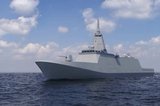MBDA to provide Sea Ceptor naval defence systems for Polish Miecznik-class frigates
Poland’s Miecznik frigates will be expected to enter service later this decade. (Image: Babcock)
Poland’s new Navy’s three new Miecznik-class frigates will be fitted with MBDA’s Sea Ceptor naval air defence system under a contract announced on 12 January.
The new generation naval air defence system Sea Ceptor has been designed to protect naval vessels from modern air and surface threats, such as supersonic anti-ship missiles and unmanned surface vessels, as well weapons used for more conventional attacks.
Sea Ceptor uses the Common Anti-air Modular Missile (CAMM) which is a short-range, anti-aircraft and anti-missile surface-to-air missile, but is also suitable for surface attacks, having been tested and trialled in this role.
Related Articles
Babcock wins Polish Miecznik frigate competition
MBDA strikes $2.4 billion anti-air deal with Poland
New Zealand's HMNZS Te Mana successfully fires first Sea Ceptor missile
CAMM will be installed on board with a quadpacking solution in Mk41 Vertical Launching System (VLS) enabling a high load-out and increasing platform survivability. The CAMM family has also been used in Poland’s PILICA+ and NAREW programmes.
The Miecznik frigates will be based on the Babcock Arrowhead 140 design, already selected by the UK Royal Navy and the Indonesian Navy. Three ships have been ordered by Poland, with the lead ship scheduled to be delivered in the late 2020s.
The Royal Navy’s Type 26 Global Combat Ships will carry the Sea Ceptor air defence system, with a 2016 £100 million (US$127.5 million) demonstration and manufacture contract issued to MBDA by the UK MoD
The contract will run for 10 years and will cover support to the T26 design, as well as the manufacture of the electronics equipment required for the class of eight ships.
More from Naval Warfare
-
![Future of the Canadian Patrol Submarine Project is still unclear]()
Future of the Canadian Patrol Submarine Project is still unclear
The Canadian government remains tight-lipped on the timeline and funding required for the next steps of its Canadian Submarine Patrol Project, which should offer improved capabilities for the country’s navy.
-
![Thales’ new Sonar 76Nano could equip UK Royal Navy on anti-submarine warfare missions]()
Thales’ new Sonar 76Nano could equip UK Royal Navy on anti-submarine warfare missions
The new sonar is designed to equip uncrewed underwater vessels, with the potential to be used by the Royal Navy for its Atlantic Bastion and Atlantic Net missions.
-
![Hanwha wins Australian government approval to increase its stake in Austal]()
Hanwha wins Australian government approval to increase its stake in Austal
The contract would mean the two shipbuilders can collaborate strategically and enhance shipbuilding capabilities in Western Australia.






















